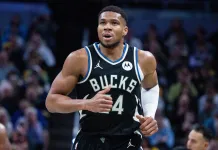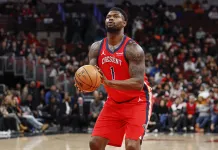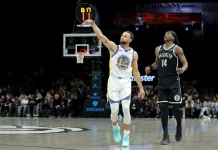Trends are cyclical in all sports. When a team or multiple teams start to have success with something new, other teams around the league try to emulate it in some fashion.
“Moneyball” in MLB is a really good example. “Moreyball,” which favors 3-pointers and layups over mid-range jumpers, is the best example in the modern NBA.
At some point, though, things can shift back. Maybe not all of the way, but at least to a degree.
In the NFL this season, for example, you might have noticed that teams running the ball effectively are having a lot of success. Defenses are hyper-focused on stopping the pass. NFL rules favor the offense and, more specifically, the passing offense. Offenses have a lot of run-pass option concepts in the playbook as well. And tight ends are more of a receiving threat downfield than we’ve seen before.
As a result, NFL defenses are playing more Cover-2, Cover-3, Quarters and other forms of zone in hopes of keeping everything in front of them and avoiding big plays. Defenses are also prioritizing pressure with the front four on the defensive line to leave as many guys in coverage as possible. With all of that, the running game is making a bit of a comeback.
How does that relate to the NBA? Well, while we’ve seen a seismic shift to 3-point shooting over the last few years, we’re now seeing some teams shift back the other way and put more of an emphasis on the mid-range game.
“3DO”
In last year’s NBA Betting Guide, I wrote about the concept of “3DO” — the “3” is for 3-pointers, the “D” is for defending the 3 (Defensive Rating) and the “O” is for offensive rebounding. The 3-point attempt rate (3PAr) has continued to rise season after season and that was true again in 2021-22, as 39.9% of field-goal attempts were 3s.
Those three statistical areas are all really important. Teams that take a lot of 3s and have success making them are usually pretty good. Teams that play good defense usually make the playoffs and have the best chance of playing for a championship when they get there. Finally, offensive rebounds are extra possessions that usually lead to points.
The trend to prioritize 3-point shooting is not a secret. A lot of teams are doing it, but not all of them. Others have found something new and that is what I want to focus on for this year’s preseason deep dive.
The Return of the Mid-Range J?
In college basketball and the NBA, mid-range jumpers are looked down on. All 2-point shots are worth the same value, but a shot attempt at the rim is much easier to make than a jump shot. As a result, most coaches, especially those with a background in analytics, instruct players to only shoot jumpers in an emergency.
2-point FG% by Distance in NBA
0-3 feet: .687
3-10 feet: .439
10-16 feet: .431
16%plussign% feet: .400
I just mentioned that teams across the league are putting extra emphasis on shooting 3s. A 3-pointer is worth more than a 2-pointer and a jump shot outside of 10 feet only carries about a 7% higher likelihood of being made than a 3-point shot, based on league averages from last season.
However, here is the caveat and what some teams are now trying to exploit: Teams are placing all of their defensive focus on defending the perimeter and defending the rim. What does that leave open? The mid-range.
The top eight teams in FG% between 10-16 feet all made the playoffs last season (Suns, Nets, Pelicans, Jazz, Mavericks, Bulls, Bucks, Hawks), as did 10 of the top 11 (Nuggets, Heat).
The top six teams in FG% from 16 feet to the 3-point line made the playoffs (Nets, Bulls, 76ers, Hawks, Suns, Nuggets) and five of the top six teams in field goal attempt percentage from that distance made the playoffs (Bulls, Raptors, Nets, Hawks, Suns).
We’re seeing something of a shift in the NBA, where the mid-range jumper is making a comeback. Because that area of the floor is often neglected by opposing defenses, some teams are scheming to create those open shots.
When everybody is zigging, somebody should be zagging. Forcing teams to defend the mid-range takes them out of their normal defense. As long as you have the personnel to make those shots, it can be a viable offensive strategy.
The Betting Impact
Truthfully, this level of analysis might be a year or two early, but it does seem as though changes will be coming. We’ve seen decreases each year in terms of mid-range jumpers, but I can’t help but wonder if that stops this season.
Percentage of FG attempts from 10-16 feet, 16 feet-3P line
2017-18: 10.6%; 12%
2018-19: 9.6%; 9.2%
2019-20: 9.3%; 7.7%
2020-21: 9.6%; 7.2%
2021-22: 9.4%; 7.1%
League average 3P%
2017-18: 36.2%
2018-19: 35.5%
2019-20: 35.8%
2020-21: 36.7%
2021-22: 35.4%
As you can see, 2020-21 (the weird COVID season) was an outlier. With no fans or limited fans, perhaps the different shooting backdrop was helpful. Perhaps teams just didn’t give the same defensive effort. Whatever the reason, 3P% has been pretty stable year-over-year for a while.
Last season, though, the Heat led the NBA at 37.9%. That was the lowest mark to lead the league since the 1998-99 season. We’re seeing teams adjust the defensive details to account for intently guarding the 3-point line.
I think it could lead to some lower-scoring games as we move forward. Totals have been on the rise on an annual basis for a while because of the increase in 3-point attempts. With successful teams like the Suns and Bucks taking more mid-range shots, others around the league will start to take notice.
My guess is we’ll also see the pace slow down. It takes time on an offensive possession to create a mid-range jump shot, as evidenced by the fact that the 76ers, Celtics, Heat and Mavericks were all among the bottom 10 in pace.
We could really see basketball tighten up the way some other sports have, and that merits watching as this NBA season goes along.





